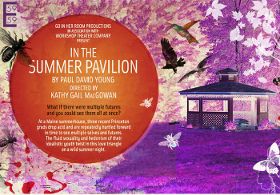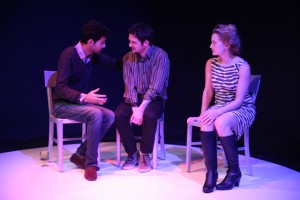WELL INTENTIONED, ILL-CONCEIVED
Whispers of “pretentious†could be heard in the audience of Paul David Young’s new play In the Summer Pavilion, which doesn’t seem like a fair assessment. Calling a work pretentious suggests a certain lack of sincerity on the part of its creator, as if he’s more concerned with showing off his abilities than attempting to realize an idea the universe has entrusted him with. Mr. Young’s efforts seem in earnest; he appears to want to convey a vision he was moved by. Unfortunately Pavilion, a play with ambitious goals and many fine elements, doesn’t quite work, and its problems, with both script and direction, are conceptual.
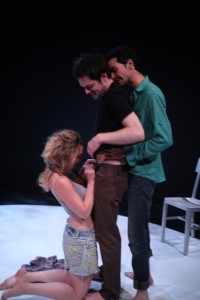 The show begins with Ben (an intense Ryan Barry) coming out onto a near-empty black box stage – there are three chairs standing around a big white circle painted in the middle – and delivering a baroque, poetic monologue, suggesting, among other things, that what we are about to see – and I’m summarizing – will blow our minds. Then another young man and woman enter, Nabile (Meena Dimian) and Clarissa (Rachel Mewbron); all three are friends, sometime-lovers and recent Princeton graduates. Already inebriated from a party, the trio drop acid. There are some psychedelic lighting and sound effects, then all is darkness. When the lights come on we find ourselves watching the trio in a scene from some years in the future, or rather from one possible version of their future, in the alternate-reality meta-universe sense. Pavilion consists of five such scenes, all variants of what might happen to these people ten years or so down the line.
The show begins with Ben (an intense Ryan Barry) coming out onto a near-empty black box stage – there are three chairs standing around a big white circle painted in the middle – and delivering a baroque, poetic monologue, suggesting, among other things, that what we are about to see – and I’m summarizing – will blow our minds. Then another young man and woman enter, Nabile (Meena Dimian) and Clarissa (Rachel Mewbron); all three are friends, sometime-lovers and recent Princeton graduates. Already inebriated from a party, the trio drop acid. There are some psychedelic lighting and sound effects, then all is darkness. When the lights come on we find ourselves watching the trio in a scene from some years in the future, or rather from one possible version of their future, in the alternate-reality meta-universe sense. Pavilion consists of five such scenes, all variants of what might happen to these people ten years or so down the line.
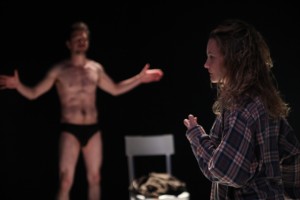 In one version Ben and Clarissa are married, she’s a successful painter, and Nabile is in love with Ben. In another Nabile is married to Clarissa, who’s given up painting, and Ben is their mutual friend. In the third Clarissa is a successful art dealer, she’s close with Nabile, and all Ben appears to mean to her is a possible sale. In the fourth (and particularly unbelievable) version Ben, who up until now has been a straight guy with bi tendencies, turns into a flamboyant homosexual who’s in love with Nabile. And in the fifth version Ben is a recovering junky who finds dubious enlightenment.
In one version Ben and Clarissa are married, she’s a successful painter, and Nabile is in love with Ben. In another Nabile is married to Clarissa, who’s given up painting, and Ben is their mutual friend. In the third Clarissa is a successful art dealer, she’s close with Nabile, and all Ben appears to mean to her is a possible sale. In the fourth (and particularly unbelievable) version Ben, who up until now has been a straight guy with bi tendencies, turns into a flamboyant homosexual who’s in love with Nabile. And in the fifth version Ben is a recovering junky who finds dubious enlightenment.
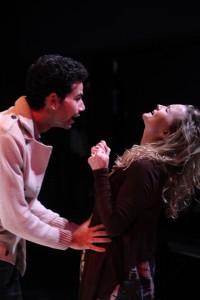 A question arises: Are we watching LSD-induced fantasies or are these in fact alternate realities? Mr. Young appears to be saying they can be both or either, which seems at once a lofty and precarious position for a playwright to take. But ok, let’s assume we are watching a dream (if it can be a fantasy then we have to assume that it is). Dreams can work if they reveal to us some profound truth. Unfortunately, this one doesn’t reveal anything. It shows us, as statements of fact, that depending on circumstances (which we are never aware of) the same twenty-two-year-old can turn into a PhD, a financial wizard, an advertising executive, or a junky. But so what? Where’s the fantastic world and mind-blowing insights we were promised? Is the idea that where a person ends up depends largely on luck and the circumstances of his life supposed to be awe-inspiring? Not only are these “insights†banal but the different scenes are quotidian and lack drama; they feel like foregone conclusions, with beginnings and ends but no middles.
A question arises: Are we watching LSD-induced fantasies or are these in fact alternate realities? Mr. Young appears to be saying they can be both or either, which seems at once a lofty and precarious position for a playwright to take. But ok, let’s assume we are watching a dream (if it can be a fantasy then we have to assume that it is). Dreams can work if they reveal to us some profound truth. Unfortunately, this one doesn’t reveal anything. It shows us, as statements of fact, that depending on circumstances (which we are never aware of) the same twenty-two-year-old can turn into a PhD, a financial wizard, an advertising executive, or a junky. But so what? Where’s the fantastic world and mind-blowing insights we were promised? Is the idea that where a person ends up depends largely on luck and the circumstances of his life supposed to be awe-inspiring? Not only are these “insights†banal but the different scenes are quotidian and lack drama; they feel like foregone conclusions, with beginnings and ends but no middles.
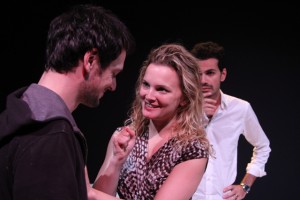 The structure Mr. Young chooses makes story development difficult: the episodes are not connected by a plot. In such cases it’s essential for the work to have a solid thematic progression through which a wholeness, with real drama and profundity, can be achieved; with each new incarnation of a character we must learn something new about his or her essence until finally, at the end, we experience a revelation. Nothing of the sort happens in Pavilion and if a developing theme exists I could neither see it not feel it. Taken together the individual episodes don’t amount to more than the sum of their parts.
The structure Mr. Young chooses makes story development difficult: the episodes are not connected by a plot. In such cases it’s essential for the work to have a solid thematic progression through which a wholeness, with real drama and profundity, can be achieved; with each new incarnation of a character we must learn something new about his or her essence until finally, at the end, we experience a revelation. Nothing of the sort happens in Pavilion and if a developing theme exists I could neither see it not feel it. Taken together the individual episodes don’t amount to more than the sum of their parts.
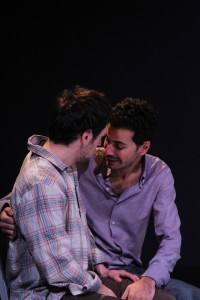 Kathy Gail MacGowan expertly directs her actors, skillfully realizing her concept of Pavilion, unfortunately that concept leaves much to be desired. With a nearly bare stage and expressionistic lighting and sound design (outstanding job by lighting designer Kia Rogers and sound designer Julian Evans) Ms. MacGowan seems to be trying to convey, among other things, the experience of an inward LSD-aided journey. Yet the episodes as staged feel too literal, their worlds too small and commonplace to communicate the magic, depth and power of such a trip. The characters and their surroundings are too similar from one scene to the next, which undermines the play’s central theme, that being those characters’ dissimilarity from future to future. It seems Ms. MacGowan could have gotten a lot more mileage by making the settings and the various versions of the personages radically different from one another while keeping their essence intact (which seems to be the intention behind Mr. Young’s play). Staged in that way we could have had the fantastic journey Ben promises us in the beginning. Also, when Ben, a mostly straight man in four of the five episodes, suddenly becomes completely gay in one of them, it wouldn’t feel like a problem.
Kathy Gail MacGowan expertly directs her actors, skillfully realizing her concept of Pavilion, unfortunately that concept leaves much to be desired. With a nearly bare stage and expressionistic lighting and sound design (outstanding job by lighting designer Kia Rogers and sound designer Julian Evans) Ms. MacGowan seems to be trying to convey, among other things, the experience of an inward LSD-aided journey. Yet the episodes as staged feel too literal, their worlds too small and commonplace to communicate the magic, depth and power of such a trip. The characters and their surroundings are too similar from one scene to the next, which undermines the play’s central theme, that being those characters’ dissimilarity from future to future. It seems Ms. MacGowan could have gotten a lot more mileage by making the settings and the various versions of the personages radically different from one another while keeping their essence intact (which seems to be the intention behind Mr. Young’s play). Staged in that way we could have had the fantastic journey Ben promises us in the beginning. Also, when Ben, a mostly straight man in four of the five episodes, suddenly becomes completely gay in one of them, it wouldn’t feel like a problem.
The young actors do a fine job with the tasks they are given. Under a microscope in such a tiny theater they are present and energized, giving layered performances, taking their time and hitting their beats. I only wish the goals the playwright and director set for them were a bit less mundane.
photos by Gerry Goodstein
In the Summer Pavilion
Go in Her Room Productions in association with Workshop Theater Company at 59E59 Theaters in New York City
scheduled to end on November 3, 2012
for tickets, call (212) 753-5959 or visit http://www.59e59.org/
